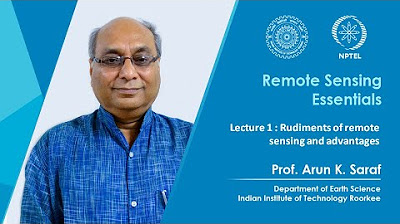Penginderaan Jauh: Pertemuan 1
Summary
TLDRIn this lecture, the professor introduces remote sensing, its history, and its applications in geomatics. The course covers the evolution of remote sensing technology, from early methods like aerial photography using balloons and kites to modern satellite platforms. Students will explore the fundamental principles of remote sensing, including electromagnetic waves, sensors, and platforms. The course will also focus on various techniques such as image interpretation, radiometric calibration, and geometric correction. The history of remote sensing, starting with the use of simple tools to modern space-based technologies, is discussed in depth, emphasizing its military and civil applications.
Takeaways
- 😀 The course is about remote sensing, which focuses on acquiring information about objects without direct physical contact using electromagnetic radiation, especially for monitoring Earth's surface.
- 😀 The course was intended for semester 5 but is being introduced later, and will be taught remotely due to current circumstances.
- 😀 Data processing for the course will be done online, using platforms like Google Earth Engine instead of traditional desktop software.
- 😀 Students will have access to all course materials, including slides and assignments, via an online platform (PSM classroom), and must stay updated with notifications for any changes.
- 😀 Attendance will be tracked through an online tool, with presences to be filled out 15 minutes before class starts.
- 😀 The course will cover fundamental remote sensing concepts, including electromagnetic wave spectra, sensor types, and different resolutions.
- 😀 Topics to be covered include the principles of image interpretation, radiometric calibration, and geometric correction of remote sensing data.
- 😀 Historical methods of remote sensing, such as aerial photography using balloons, kites, and pigeons, are discussed as precursors to modern satellite technologies.
- 😀 The first satellite used for remote sensing was launched in 1972, marking a significant milestone in space-based Earth observation.
- 😀 The course will also address the ethical use of data, including understanding how past military satellite projects (like the 'Corona' program) were eventually declassified for public use.
- 😀 The course's final project will involve students applying remote sensing techniques to real-world data, ensuring they gain practical experience with current technologies.
Q & A
What is the main focus of the lecture discussed in the transcript?
-The lecture focuses on remote sensing, its definitions, history, and various principles and techniques associated with it, particularly in monitoring the Earth using electromagnetic radiation without physical contact.
Why is remote sensing considered a mandatory subject in the curriculum?
-Remote sensing is a mandatory subject because it is the only required course related to remote sensing technology, which is essential for understanding Earth observation and various geospatial applications.
What changes have been made to the course delivery this semester?
-This semester, the course has been adapted to a fully online format, with no need for downloading large data sets or using desktop software. Instead, practical exercises will be conducted online using platforms like Google Earth Engine.
What platforms will students use for practical exercises in remote sensing?
-Students will use 's.com Network' for simulations and Google Earth Engine for processing and analyzing remote sensing data during practical exercises.
What is the definition of remote sensing as mentioned in the lecture?
-Remote sensing is defined as the acquisition of data without physical contact with the observed object, particularly through the use of electromagnetic radiation to gather information about the Earth's surface, atmosphere, and oceans.
What key concepts are emphasized in the first week of the lecture?
-In the first week, the lecture covers the definition of remote sensing, its history, and its development, particularly focusing on early methods of obtaining data without direct contact.
How has the technology behind remote sensing evolved over time?
-Remote sensing technology has evolved from early techniques like using balloons, kites, and pigeons to the modern use of satellites equipped with advanced sensors for Earth observation.
What historical milestones in remote sensing were discussed in the transcript?
-The historical milestones include the use of balloons for aerial photography in 1859, the first use of airplanes for aerial imagery in 1908, and the development of satellite-based remote sensing in 1972 with the launch of Earth Resources Technology Satellite (ERTS), now Landsat.
What are the three key elements that define remote sensing in the context of Earth observation?
-The three key elements are: (1) the use of electromagnetic radiation, (2) the observation of Earth’s surface, oceans, and atmosphere, and (3) the absence of physical contact between the observer and the object being observed.
What role did World War I and II play in the development of aerial remote sensing techniques?
-During World War I and II, aerial photography became crucial for military purposes, such as mapping enemy territory and gathering intelligence. This significantly advanced the use of aerial imagery and remote sensing techniques for strategic purposes.
Outlines

This section is available to paid users only. Please upgrade to access this part.
Upgrade NowMindmap

This section is available to paid users only. Please upgrade to access this part.
Upgrade NowKeywords

This section is available to paid users only. Please upgrade to access this part.
Upgrade NowHighlights

This section is available to paid users only. Please upgrade to access this part.
Upgrade NowTranscripts

This section is available to paid users only. Please upgrade to access this part.
Upgrade NowBrowse More Related Video

Lecture 1 : Rudiments of Remote Sensing and Advantages

GEO 1 4 FIN

Bagaimana Cara Mengintepretasikan Citra Penginderaan Jauh?

Rangkuman Materi: Penginderaan Jauh

Pengindraan Jauh atau Remote Sensing #geography #education #kurikulummerdeka #remotesensing

Geografi Kelas XII (9) Pemanfaatan peta, penginderaan jauh, SIG untuk jaringan transportasi
5.0 / 5 (0 votes)